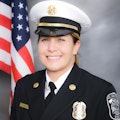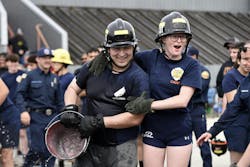Theodore Roosevelt said, “Believe you can and you’re halfway there.” There are countless testimonials from women and people of color who are in the fire service that affirm that they needed a dose of “can” that came in the form of a person who looked like them in the role. They literally had to “see it” to believe that they could “be it.”
Opening hearts and minds
When it comes to forming our identity, seeing people who are like us who have been successful in a certain rank or position is incredibly important. That’s very empowering and motivating. We can envision ourselves in that same position and feel more confident in our ability to pursue that career path. Additionally, representation also can provide us with role models and mentors who can guide us on our journey and offer valuable advice and support. This not only helps us to shape our own identity but also creates a more diverse and inclusive workforce, which benefits the fire service and society as a whole.
The California State Firefighters’ Association (CSFA) is leading the way for young people to see fire and EMS professionals who look like them. CSFA supports first-responder pathways programs across the state of California that introduce young people to the fire service. The CSFA team collaborates on girls empowerment camps, youth fire camps, fire explorer programs, community risk reduction (CRR) internships and more. The leadership team includes firefighters who not only look like the young people but also share similar backgrounds and experiences. The young people can see individuals who have faced difficult life experiences, made mistakes and struggled but still were able to obtain a rewarding career in the fire service.
Girls empowerment camps
The girls empowerment camps (for girls who are ages 12 to 19) that the CSFA supports provide a safe and reassuring environment for the girls to learn, grow and develop important life skills along with firefighting skills. Furthermore, participants gain an understanding of what it takes to be a firefighter as well as what is required to serve in other career positions within the fire service.
The camps are open to all genders and nonbinary persons but focus on communication and learning styles of girls in an environment in which they are encouraged to express themselves freely without fear of judgment.
To help to make girls feel safe and supported, they are encouraged to ask any questions about anything. Questions that were posed include: How do you keep your hair secured in a helmet? What do you do when you are on your period?
The girls are divided into groups that contain a mixture of ages. Usually, an older girl or a girl who has some fire experience will be a team leader.
Each station of the camp is taught by a woman firefighter. This way, if a camp participant doesn’t believe that she can, for example, start a chainsaw, she is able to see a woman do it safely.
Youth fire camps
The one-day youth fire camps are advertised to all genders and nonbinary persons. The age groups are determined among the collaborating partners that are within the community and the participating fire department(s).
The camps provide a basic introduction to the fire service. Participants are familiarized with PPE, hoselays, ladder-throwing and EMS skills. They are given a PowerPoint presentation on the different career paths that are available, including CRR, ambulance operator, dispatcher and lifeguard.
To minimize the “death by PowerPoint” effect, for each slide, a person from each position (structural firefighter, wildland firefighter, EMT, paramedic, CRR inspector, environmental safety inspector, arson investigator, dispatcher, lifeguard, emergency management coordinator and administrative support) talks about what that individual does and answers questions. The participants always love the dog handlers, whether regarding arson, search and rescue, or emotional support.
The camps also serve as recruitment fairs for college pathway programs, ambulance companies, fire explorer and intern programs, and other organizations that give the attendees the tools and the exact steps to follow for a career that interests them.
Fire explorer programs
The fire explorer programs are designed for all genders and nonbinary persons who are ages 15 to 20 years old. The programs are a joint venture with the Learning for Life program, which is designed to support schools and community-based organizations in their efforts to prepare youth for the complexities of society.
Participants complete a two-day orientation or a five-day explorer academy.
People who become explorers attend meetings once or twice per month, participate in physical activities and firefighting skills, and use firefighting equipment. Life skills, such as financial education and how to write a resume, also are taught. Certified explorers may participate in ride-alongs during responses to emergency calls.
Mentorships
Recruitment isn’t the only result of when someone “sees” someone who is like them. Mentorship by someone who looks like another person and shares similar experiences and background with that person is crucial for personal and professional growth. Of course, mentors can offer valuable insights and advice, which can be incredibly helpful in navigating challenges and making important decisions. This bolsters trust, relatability and a deeper level of connection, which provides a sense of belonging and support. An environment that’s psychologically safe empowers the mentee to thrive.
Although having a mentor who shares a similar background and experiences is beneficial, having a mentor who is different than a mentee can bring a new perspective as well as a diverse set of skills to the table. This can help to broaden mentees’ understanding and to challenge their own beliefs and biases.
The key to mentoring someone who doesn’t look like the mentor is establishing trust. Feedback and guidance shouldn’t be judgmental. Mentors must have a strong character, too. They will be questioned by others as to why they are mentoring a person who doesn’t look like them.
Mentees deserve a well-rounded mentorship experience that’s facilitated by being introduced to different ways of thinking and problem-solving.
Allies and sponsors
Allyship and sponsorship are aspects of mentorship that are critically important in the fire service. Allyship involves creating a supportive and inclusive environment for underrepresented individuals; sponsorship involves actively advocating for and promoting a firefighter’s career advancement.
By having allies who are in the workplace, firefighters can feel more confident and supported in their role, which helps to lead the individual to success.
Having a sponsor can provide valuable opportunities for career growth and advancement, because sponsors can use their influence and connections to open doors for their protege, including a person who “isn’t expected to do well.” Good sponsors intentionally prepare and train their mentee in front of others, so these others can see for themselves that the mentee is a worthy competitor.
Both allyship and sponsorship can help firefighters to gain visibility and recognition within their organization, which can lead to more opportunities for promotion and advancement.
Outside opportunities
What if members don’t have a mentor who looks like them in their department? There are great organizations that provide support to women, people of color and nonbinary individuals in the fire service. Some examples are Los Angeles County Stentorians, Los Bomberos de L.A. County, The Oakland Women’s and Non-binary Firefighters (TOWNFF) and the Women’s Fire Alliance.
Everyone wins when a diverse workforce of fire service personnel reflects the community that it serves. Representation in leadership positions can serve as a source of inspiration and motivation for individuals from underrepresented groups to join and excel in the fire service.
How can you help? The fire service needs mentors from all demographics in our organizations. Become a mentor, ally or sponsor. Lead by example. Perhaps others need to “see it” before they can “be it,” too.
About the Author

Deena Lee
Deena Lee is the chairperson of the Pathways Committee for the California State Firefighters’ Association. In April 2023, she retired as the first female fire chief in the South Bay region of Los Angeles County. At her time of appointment, Lee was the only female fire chief in Los Angeles, Orange and Ventura Counties. She started her fire career with the El Segundo, CA, Fire Department (ESFD) in 2003 after spending two years as a volunteer with the La Habra Heights, CA, Fire Department and working as an apprentice with the La Verne, CA, Fire Department. At the ESFD, Lee was promoted to captain in 2007, battalion chief in 2019 and fire chief in 2021. She is a California State Fire Marshal Instructor and works at El Camino College Fire Academy. Lee has a bachelor’s degree in fire science and multiple certifications, including Chief Fire Officer. She is a founding member of Women’s Fire Alliance and brought the first “Fired Up! Girls Empowerment Camp” to El Segundo for youths of ages 12 to 19.

